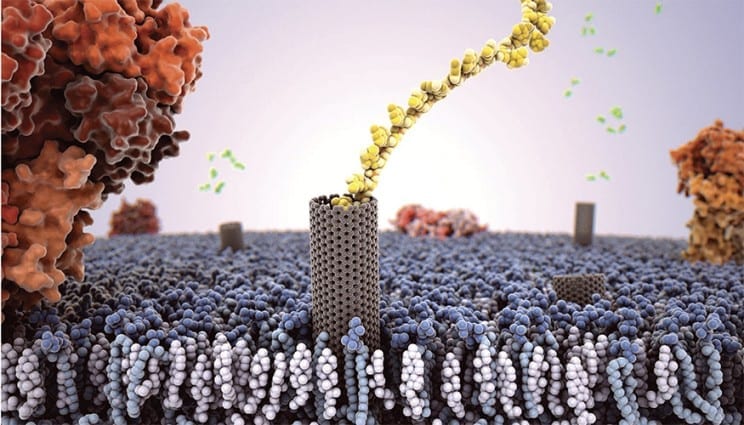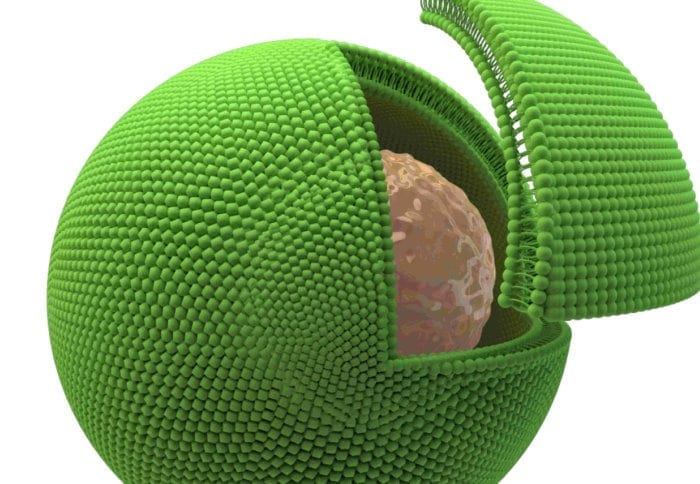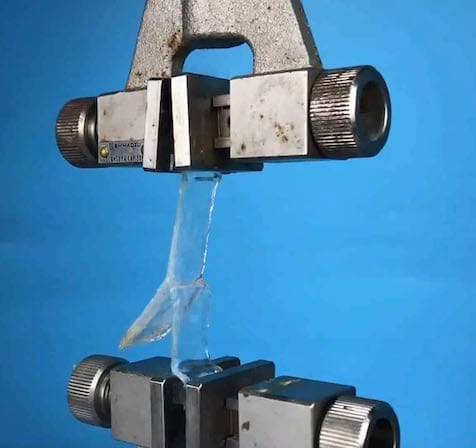
Proteins in lipid membranes are one of the fundamental building blocks of biological functionality. Lawrence Livermore researchers have figured out how to mimic their role using carbon nanotube porins.
Using high-speed, atomic force microscopy (HS-AFM), the team showed that a new type of biomimetic channel — carbon nanotube porins (CNTPs) — also is laterally mobile in supported lipid membranes, mirroring biological protein behavior.
The research opens the door to use CNTPs as models to study membrane protein physics, as well as versatile and mobile components for artificial cells and hybrid systems that combine biological cells and man-made components.
Lipid membranes represent one the fundamental components of the architecture of life because they provide a versatile matrix for a variety of membrane proteins that can perform a variety of tasks including molecular recognition and signal transduction, metabolite transport and membrane remodeling.
The 2D fluid nature of the lipid membrane not only allows it to adapt to a variety of shapes, but also permits membrane proteins to diffuse within this 2D plane, enabling many important biological processes.
“To understand the fundamental physics of protein motion in the lipid membrane, we needed an approach that would combine simple and robust membrane protein models with imaging and tracking approaches that can follow membrane motion on the relevant length and time scales,” said Yuliang Zhang, an LLNL postdoctoral researcher and lead author of a paper in the journal, Philosophical Transactions of the Royal Society B.
The team created simple and versatile artificial membrane pore equivalents — CNTPs —that are made of short segments of single-wall carbon nanotubes that can self-insert into the lipid membrane and form a transmembrane pore. These very simple objects show a wealth of behaviors similar to membrane protein pores: they can transport water, ions and protons across the membrane.
“We found that the CNTPS were able to reproduce another key property of membrane proteins — their ability to diffuse in the lipid membrane,” said Alex Noy, LLNL scientist and the principal investigator on the CNTP project. “High-speed AFM imaging can capture real-time dynamics of CNTP motion in the supported lipid bi-layer membrane.”
Zhang said the study demonstrates that the similarities between CNTPs and biological membrane pores include not only similar transport properties, but also the ability to move laterally in the membrane.
Learn more: Carbon nanotubes mimic biology
The Latest on: Carbon nanotube porins
[google_news title=”” keyword=”carbon nanotube porins” num_posts=”10″ blurb_length=”0″ show_thumb=”left”]
via Google News
The Latest on: Carbon nanotube porins
- Breaking Kasha's ruleon April 29, 2024 at 2:27 pm
The emission of visible light from a dye encapsulated within a carbon nanotube gives great hope and new opportunities for the design of nanoscale optoelectronic devices. The physical principle of ...
- Scientists stencil-paint carbon nanotube components for flexible transparent electronicson April 23, 2024 at 9:23 am
Researchers from Skoltech, MIPT, and elsewhere have found a fast and inexpensive way to create geometric patterns in carbon nanotube films. The resulting films turned out to have superior properties ...
- What are carbon credits and how much are they?on April 21, 2024 at 5:00 pm
Advisors to former US climate envoy John Kerry vigorously pushed the world's leading corporate climate targets oversight committee to change its stance against the use of contentious carbon ...
- 2022 Carbon Credits Landscapeon April 20, 2024 at 4:47 am
Carbon credit markets have grown in recent years, but there is still much debate over how effective they are at reducing emissions. Our 2022 report evaluates pricing trends and the potential of ...
- Carbon Dioxide Levels Have Passed a New Milestoneon April 19, 2024 at 4:59 pm
Source: National Oceanic and Atmospheric Administration’s Global Monitoring Laboratory The chart shows monthly numbers of carbon dioxide molecules per million molecules of dry air. Because of ...
- Apple wants to improve the carbon offset marketon April 17, 2024 at 5:00 pm
Apple has published its annual environmental report detailing its progress towards becoming completely carbon neutral by 2030. While critics will, of course, condemn the report as “greenwash ...
- Think twice about buying carbon offsets when you flyon April 17, 2024 at 2:58 pm
The travel industry knows this too, so airlines and some travel websites have made it easy to feel like you're mitigating all that burned jet fuel by buying something called a carbon offset.
- Safety first: These 5 home devices require regular maintenance checks, experts sayon April 16, 2024 at 4:01 am
Whether you are a homeowner, renter or just temporarily staying in a space, neglecting to routinely check certain devices, such as smoke and carbon monoxide detectors, can be hazardous.
- Carbon markets proliferate worldwide — reporton April 16, 2024 at 3:15 am
Washington state’s carbon market was one of five new or heavily revised systems to launch in 2023, adding to what the International Climate Action Partnership called a “rapid expansion” in ...
- The unassuming material that could soak up carbon emissionson April 6, 2024 at 4:00 am
Glacier flour is on the mountain where ice has melted at the Ossoue glacier on the Vignemale peak in the French Pyrenees in September 2021. The Ossoue glacier is the highest and largest glacier in ...
via Bing News










